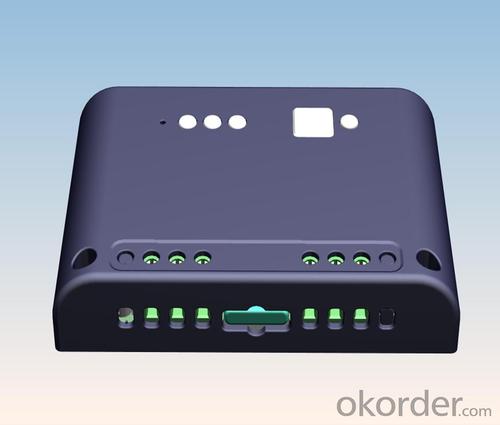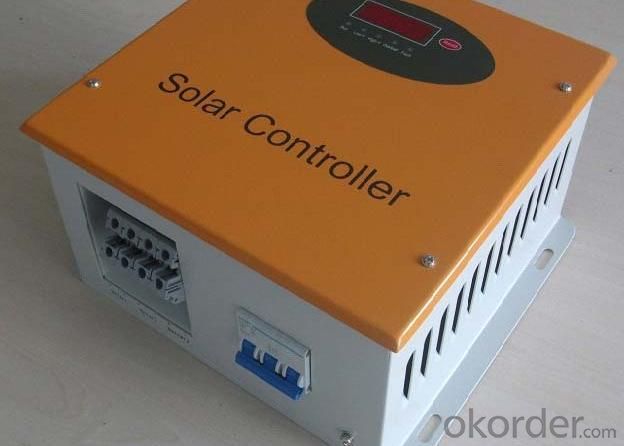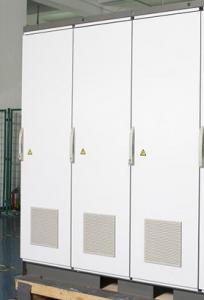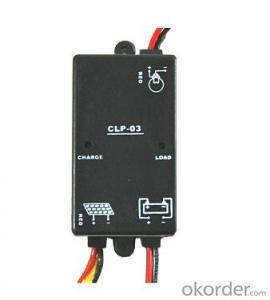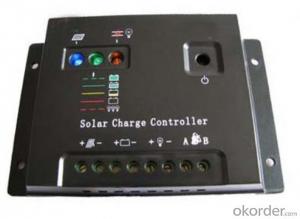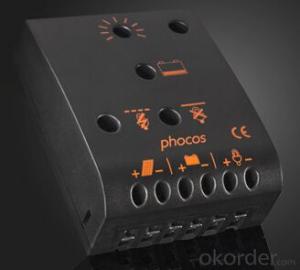H-Series Lithium-Ion Solar PV Controller
- Loading Port:
- Nanjing
- Payment Terms:
- TT/LC
- Min Order Qty:
- 50sets set
- Supply Capability:
- 1-3000sets/month set/month
OKorder Service Pledge
OKorder Financial Service
You Might Also Like
Main features of H-Series PV controller:
Professional MCU microprocessor control, the real charge and discharge of intelligent control;
Total negative control mode, multi-channel input matrix control of solar cells
High pressure, long life of the IGBT as the main switching device controller
Brightest charge voltage detection with "bad back" control to prevent switching into oscillation state
Control circuit and main circuit completely isolated, with a high anti-interference ability
Protection function, operation status, fault LED indicate
Low-power display state, further reducing its loss
Enables parallel operation of multiple machines
Against reverse battery
Remote monitoring (optional)
Optional Configuration of H-Series PV controller:
RS485/RS232 Remote monitoring;
Increase output control
Technical Data of H-Series PV controller:
Voltage level | 12V | 24V | 48V | 110V | 220V |
Rated current range | 30A~100A | 30A~100A | 20A~80A | 20A~60A | 20A~50A |
Battery input | |||||
Rated input voltage (VDC) | 12 | 24 | 48 | 110 | 220 |
Under-voltage protection (VDC) | ≤10.8 | ≤21.6 | ≤43.2 | ≤99.0 | ≤198.0 |
Recovery voltage (VDC) | ≥12.3 | ≥24.6 | ≥49.2 | ≥115.0 | ≥230.0 |
Over-voltage protection (VDC) | ≥16.5 | ≥33.0 | ≥66.0 | ≥150.0 | ≥290.0 |
Over-voltage recovery (VDC) | ≤15.5 | ≤31.0 | ≤62.0 | ≤142.0 | ≤284.0 |
Solar energy input | |||||
Max. open circuit voltage (VDC) | 25.0 | 50.0 | 100.0 | 230.0 | 450.0 |
Max. charge current (A) | 100 | 100 | 80 | 60 | 50 |
Allow PV array points (N) | 5 | ||||
Float voltage (VDC) | 13.7 | 27.4 | 54.8 | 125.0 | 251.0 |
Overcharge protection voltage (VDC) | ≥14.4 | ≥28.8 | ≥57.6 | ≥132.0 | ≥264.0 |
Charge recovery voltage (VDC) | ≤13.2 | ≤26.4 | ≤52.8 | ≤121.0 | ≤242.0 |
DC output | |||||
Rated output voltage (VDC) | 12 | 24 | 48 | 110 | 220 |
Max. output current (A) | 100A | 100A | 80A | 60A | 50A |
Overload capacity | 120% overload 60 seconds off the output / 150% overload for 10 seconds to close the output | ||||
Protection function | Battery over charge, over discharge the battery, the battery reversed,solar cells reversed , counter-attack by night charge , overheating, output overload, output short circuit | ||||
Serial communication | RS485(A、B) | ||||
Mechanical dimensions, work environment | |||||
Size ( D x W x H ) | 350 x 500 x180 | ||||
Reference weight (Kg) | 25 | ||||
Protection level | IP41 | ||||
Max. working altitude (m) | ≤3000 | ||||
Temperature range (℃) | -20 ~ +65 | ||||
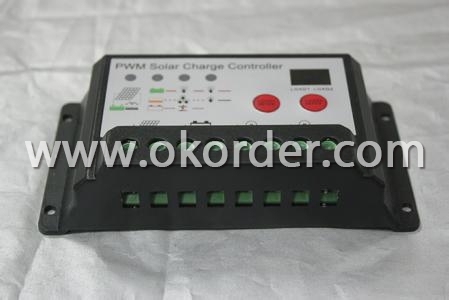
H-Series PV controller
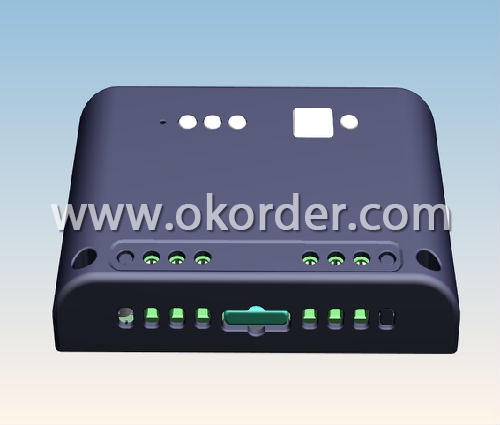
H-Series PV controller
Packaging & Delivery of H-Series PV controller:
Packaging: Wooden box or Customized
Delivery: Depends on the quantity or Customized
- Q: How do I install a solar controller?
- To install a solar controller, start by choosing a suitable location near your solar panel array or battery bank. Ensure that the area is well-ventilated and protected from extreme weather conditions. Next, mount the solar controller securely using screws or brackets. Connect the positive and negative wires from the solar panels to the corresponding terminals on the controller, ensuring proper polarity. Similarly, connect the battery's positive and negative terminals to the controller. Finally, connect any additional accessories, such as load or temperature sensors, if required. Double-check all connections, then power up the controller and configure its settings according to the manufacturer's instructions.
- Q: Can a solar controller be used with a battery bank that is being charged from other sources (e.g., grid, generator)?
- Yes, a solar controller can be used with a battery bank that is being charged from other sources such as the grid or a generator. The solar controller's main function is to regulate the charging process and prevent overcharging of the batteries. It can monitor the battery voltage and adjust the charging current accordingly, irrespective of the source of energy being used for charging.
- Q: Can a solar controller be used in an agricultural solar system?
- Yes, a solar controller can be used in an agricultural solar system. The solar controller helps regulate the charging and discharging of energy from the solar panels to the batteries, ensuring optimal performance and energy efficiency. In an agricultural solar system, the solar controller can effectively manage the power supply to various components such as irrigation systems, pumps, and lighting, helping to maximize productivity and sustainability.
- Q: How does a solar controller handle battery under-voltage disconnect recovery?
- A solar controller handles battery under-voltage disconnect recovery by monitoring the battery voltage and disconnecting the load when the voltage drops below a certain threshold. Once the battery voltage recovers and reaches a safe level, the solar controller re-connects the load to ensure the battery is protected from further discharge.
- Q: What is the purpose of the low voltage disconnect feature on a solar controller?
- In order to safeguard the batteries from over-discharge, the low voltage disconnect feature on a solar controller serves a crucial purpose. When the battery's voltage drops below a certain level, irreversible damage can occur, significantly reducing its lifespan. By monitoring the battery voltage, the low voltage disconnect feature effectively disconnects any load, such as appliances or devices, from the battery once the voltage falls below a predetermined threshold. This action prevents excessive drainage of the battery, ensuring that it retains a sufficient charge for proper functioning and longevity. Consequently, by disconnecting the load, the low voltage disconnect feature plays a vital role in protecting and optimizing the battery's performance within a solar power system.
- Q: What are the safety features of a solar controller?
- The safety features of a solar controller typically include overcharge protection, short circuit protection, reverse polarity protection, over-discharge protection, and temperature compensation. These features ensure that the solar controller regulates the flow of electricity from the solar panels to the battery system safely and efficiently, preventing any damage or hazards.
- Q: Can a solar controller handle power surges from the charge controller?
- Yes, a solar controller is designed to handle power surges from the charge controller. It has built-in protective features such as surge protection and overvoltage protection to ensure that the solar controller can withstand and regulate any power surges from the charge controller.
- Q: What is the maximum load voltage that a solar controller can handle?
- The maximum load voltage that a solar controller can handle can vary depending on the specific model and manufacturer. However, in general, most solar controllers can handle load voltages ranging from 12 volts to 48 volts.
- Q: How does a solar controller prevent overloading of the solar panel system?
- A solar controller, also known as a charge controller, plays a crucial role in preventing overloading of the solar panel system. Its primary function is to regulate the charging process and ensure that the energy generated by the solar panels is properly utilized without causing damage to the system. One of the main ways a solar controller prevents overloading is by monitoring the voltage and current levels of the solar panels. It constantly measures the input from the panels and compares it with the system's capacity. If the input exceeds the system's maximum capacity, the controller takes action to prevent overload. To prevent overloading, the solar controller employs various techniques. One common method is called pulse width modulation (PWM). PWM controllers regulate the flow of energy by rapidly switching the input current on and off. By controlling the duration of each pulse, the controller ensures that the energy delivered to the system matches the demand, preventing overload. Another technique used by solar controllers is called maximum power point tracking (MPPT). MPPT controllers optimize the efficiency of the solar panel system by finding the point at which the panels produce the maximum power output. By continuously adjusting the input voltage and current, the controller ensures the system operates at its peak performance, thus preventing overloading. Additionally, solar controllers often include safety features such as short-circuit protection and overload protection. These features detect and respond to abnormal situations, such as a sudden surge in voltage or excessive current, by shutting down the system temporarily or redirecting the excess energy to prevent damage to the panels or other components. In summary, a solar controller prevents overloading of the solar panel system by monitoring the voltage and current levels, employing techniques like PWM and MPPT to regulate the energy flow, and incorporating safety features to protect the system from abnormal situations. Its role is crucial in maintaining the efficiency and longevity of the solar power system.
- Q: Can a solar controller be used with solar-powered indoor hospitality facilities?
- Yes, a solar controller can be used with solar-powered indoor hospitality facilities. A solar controller is used to regulate and optimize the charging and discharging of batteries in a solar power system. It ensures that the batteries are charged efficiently and protected from overcharging or discharging. Therefore, it can be utilized in solar-powered indoor hospitality facilities to manage the power generated by solar panels and provide a stable and reliable source of electricity.
Send your message to us
H-Series Lithium-Ion Solar PV Controller
- Loading Port:
- Nanjing
- Payment Terms:
- TT/LC
- Min Order Qty:
- 50sets set
- Supply Capability:
- 1-3000sets/month set/month
OKorder Service Pledge
OKorder Financial Service
Similar products
Hot products
Hot Searches
Related keywords



